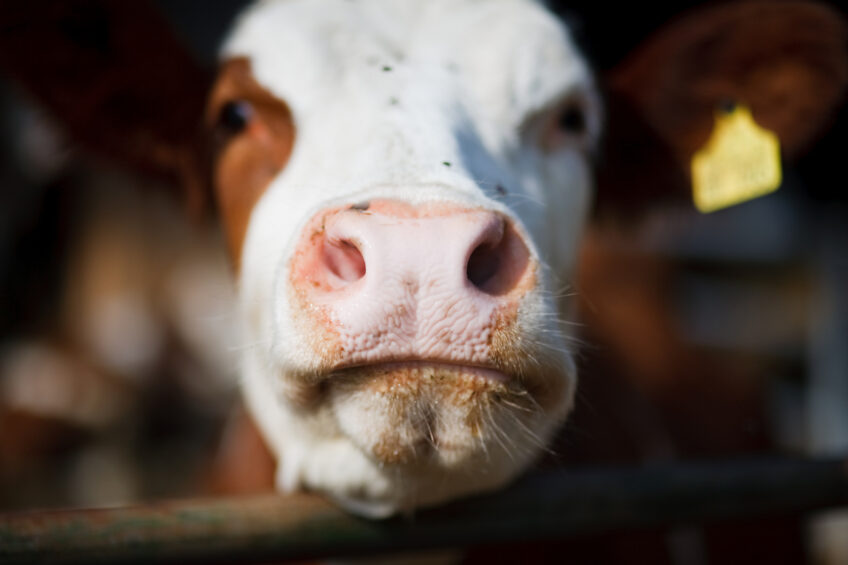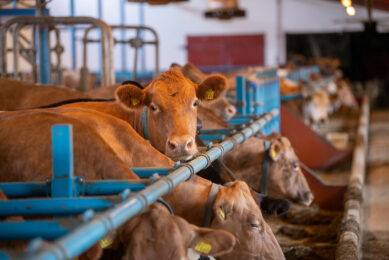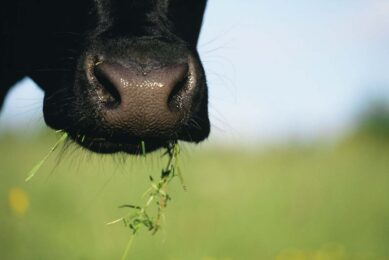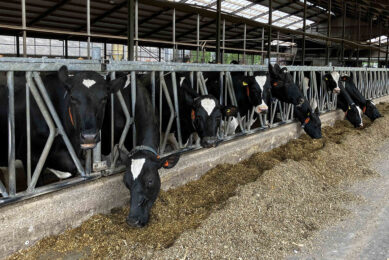Feeding protein to dairy cows: not as simple as it seems!

The efficiency with which protein is captured in milk by the dairy cow is staggeringly low. Optimising the dairy cow’s use of dietary protein would decrease associated cost for producers and minimise the environmental impact of dairy farms. This in turn will improve the sustainability and public acceptance of the dairy industry.
Although a costly ingredient, there is great potential for manipulation of amino acid supply in dairy cow rations to increase output of milk and protein yields. Great research attention has been devoted to manipulating the efficiency of milk production with focus on improving nitrogen capture. This approach requires continued understanding of the relationship between nutrition and production – information that is critical to ensure accurate prediction of cow performance based on changes in diet formulation.
Protein and energy in dairy diets
Traditionally, dairy farmers have fed diets with higher crude protein contents than their cows require as a strategy to ensure adequate supply of metabolisable protein to maximise milk and protein production. Essential amino acids (EAA) and nitrogen must be absorbed in sufficient quantities from the gastrointestinal tract to support the synthesis of milk protein and the maintenance of body tissues in the lactating cow. Dietary protein can be classified as either rumen-degradable (RDP) or rumen-undegradable (RUP) based on its susceptibility to microbial attack in the rumen. When feeding RDP, capacity for microbial protein synthesis is very dependent on dietary energy supply, regardless of the crude protein level in the diet. This energy supports the function of rumen microbes, which convert RDP sources into microbial protein. Microbial protein that flows into the lower gut constitutes a major portion of the metabolisable protein available to support milk protein synthesis in the mammary glands.
Protein used for energy rather than milk protein is expensive
Aside from comprising the building blocks for milk protein, amino acids can also function as an energy source for ruminants. In fact, there is often great competition for the use of dietary protein between milk protein synthesis in the mammary glands and gluconeogenesis, the process by which amino acids are converted to glucose, in the liver. The use of amino acids for energy rather than milk protein is not only expensive but also inefficient. Urea is produced as a by-product of gluconeogenesis, which increases nitrogen excretion through urine and milk. Thus, improving energy supply to the rumen through quality forage and a balanced ration can direct the use of dietary protein towards milk protein production while minimising amino acid catabolism to improve the balance between absorbed and excreted nitrogen.
Mammary gland protein supply
Intermediary metabolism within the ruminant can greatly alter the amino acid supply that is available to the mammary glands for milk protein synthesis. Much of the nitrogen loss in a dairy cow occurs at the postabsorptive level, once the metabolisable protein portion of their intake has reached the small intestine and amino acids have been absorbed into the arterial blood stream. Once absorbed, the splanchnic tissues (comprised of the liver, gastrointestinal tract, pancreas, and spleen) have the potential to alter and direct individual amino acids between catabolism in the liver the requirements of peripheral tissues, primarily the mammary glands. Scientific investigations over recent years have contributed to knowledge and quantification of postabsorptive amino acid use and its implication on milk protein yield. Current data clearly demonstrates that amino acid catabolism does not occur at a fixed rate, and is dependent on supply to and uptake by the mammary glands, parameters that vary across individual amino acids.

Mammary gland amino acid use
The mammary gland has the ability to alter the rate of its arterial blood supply and efficiency of nutrient extraction in order to obtain amino acids required for milk protein synthesis. Updated research findings have turned away from the classic limiting amino acid theory that suggests low supply of a single amino acid can limit milk protein production, and recognition is now being placed on the variable use-efficiencies of all EAA. The current method of establishing amino acids requirements as a portion of metabolisable protein does not allow for separate manipulation of individual EAA supply and results in rations with unnecessarily high crude protein contents.
Milk protein yield is particularly responsive to EAA, and when in abundant supply the mammary gland typically maintains a stoichiometric pattern of amino acid uptake. Of the EAA, methionine, histidine, tryptophan, phenylalanine, and tyrosine are taken up by the mammary gland at the same rate at which they are output into milk. These particular amino acids are often investigated as potential limiters of milk protein yield due to their tight economy of use and high mammary extraction efficiency. Lysine, threonine, and arginine, and the branched chain amino acids (leucine, isoleucine, and valine) are extracted by the mammary gland in excess of what is output in milk protein. The gland then uses this excess to synthesise non-EAA required for milk protein synthesis.
Because of the variation in fractional removal of amino acids by splanchnic and peripheral tissues, defining amino acid requirements as a fixed proportion of metabolisable protein supply is inaccurate and inefficient. The splanchnic tissues can significantly affect metabolism of dietary protein, with the largest portion of amino acids that become catabolized being those which are not extracted during their first pass through the mammary gland. Providing an optimal profile of specific EAA in the diet, in contrast to simply increasing crude protein content, could thereby improve mammary uptake, increase milk protein yield and reduce excess amino acid catabolism to minimize nitrogen excretion.
The animal on a cellular level
As established, the rate of protein synthesis at the tissue level is regulated by precursor supply, and the potential to minimise nitrogen excretion relies heavily on the mammary gland’s ability to effectively use amino acids for milk protein synthesis – it is ultimately the activity of individual mammary cells that are contributing to the desired lactation performance for which we formulate and feed. It is both important and practical to measure responses at the whole-animal level, but fundamental information about how milk synthesis is controlled by nutrition on a cellular level gives scientists insight into why the mammary gland responds the way it does to varying nutritional conditions.
The mammary gland of a dairy cow is unique compared with other organs, as it undergoes rapid cell proliferation leading up to parturition and steady cell death during lactation to eventually produce dry-off – a cycle that repeats itself with each calving. Individual mammary cells are responsive to specific nutrients and hormones, and understanding how amino acids and energy can alter the cell cycle and the synthetic activity within a cell could unveil unique intervention to evoke more persistent lactation and higher yields of milk and its components. Future study should focus on harmonising the performance of the whole cow to varying profiles and amounts of metabolisable protein and the implications of diet on mammary gland cellular adaptation to influence milk protein synthesis.
Precise nutrient delivery allows maximisation of milk protein output
Insight into the details of how milk protein substrates – amino acids and energy – alter metabolic function in the dairy cow and protein synthesis at the cellular level will allow for more precise nutrient delivery and opportunities to maximise milk protein output and animal efficiency while minimising the cost and environmental footprint of the dairy industry. Inclusion of variable EAA efficiencies into ration formulation and requirement prediction models should help reduce dietary protein levels by more accurately representing amino acid partitioning in the lactating dairy cow.
Join 13,000+ subscribers
Subscribe to our newsletter to stay updated about all the need-to-know content in the dairy sector, two times a week.










